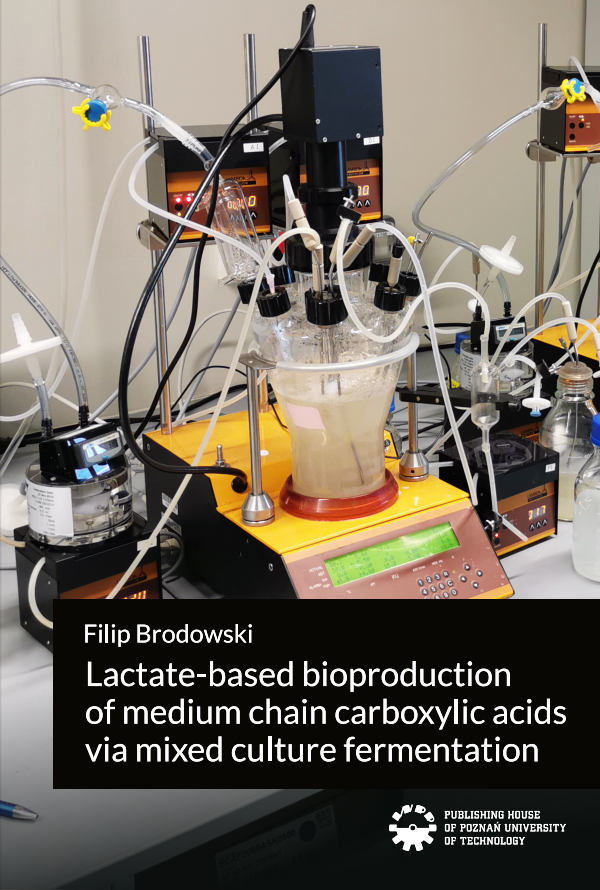Lactate-based bioproduction of medium chain carboxylic acids via mixed culture fermentation
Download Lactate-based bioproduction of medium chain carboxylic acids via mixed culture fermentation (SIN PUT)

Permission to use Lactate-based bioproduction of medium chain carboxylic acids
via mixed culture fermentation under the terms of the Creative Commons
Attribution-NonCommercial-ShareAlike 4.0 License (also known as CC BY-NC-SA),
available at https://creativecommons.org/licenses/by-nc-sa/4.0/ or any other language
version of this license or any later version of this license published by Creative Commons.
All articles included in this book are reprinted with the permission of the original
publishers.
ISBN 978-83-7775-813-7
eISBN 978-83-7775-814-4
https://doi.org/10.21008/b.978-83-7775-814-4
Abstract
The transition from a linear economy to a circular economy is the foundation of sustainable development. The bioprocessing of organic-rich waste during mixed culture fermentation has the potential to play a crucial role in the shift towards a circular economy by reducing dependence on non-renewable resources and minimizing waste. Mixed culture fermentation involves the use of diverse microorganisms to break down complex organic waste in a cascade of biochemical pathways, offering the potential for production of high-value bulk chemicals, biofuels and energy. Anaerobic digestion is commercialized and widespread technology based on mixed culture fermentation, but there is still a search for new bioprocesses to diversify bioproducts. One of the promising and growing technologies could be the bioproduction of medium chain carboxylates through the chain elongation. To enable the chain elongation, the fundamental metabolic requirement is the availability of compounds (electron donors) that supply the necessary energy, reducing equivalents (NADH), and intermediate acetyl-CoA to the reverse β-oxidation cycle (or occasionally, malonyl-CoA for fatty acid biosynthesis), wherein the carbon chain of the carboxylate is elongated by two carbon atoms in a series of enzymatic reactions, e.g. acetate is elongated to butyrate and butyrate to caproate. While various chemical compounds such as ethanol, lactate and sugars can serve as an electron donors for chain elongation, lactate-based bioconversion is receiving increasing attention. The research associated with lactate-based medium chain carboxylates production conducted so far has focused mainly on optimizing operational parameters of mixed culture fermentation such as pH, temperature, or hydraulic retention time, however, the effects of substrate composition, specifically the composition of electron donors (EDs) and electron acceptors (EAs), have not been fully explored yet. The main objective of the research was to identify the influence of lactate-based substrate composition on medium chain carboxylates production. Three long-term continuous processes and two batch experiments were conducted and described in three scientific papers. Two main following hypotheses were stated:
- The composition of lactate-based substrates, especially the lactate and acetate concentration, significantly influences the chain elongation performance.
- Utilizing a lactate-based substrate under CE-promoting conditions during MCF will lead to a microbiome enrichment in the lactate-based chain elongating bacteria.
It has been demonstrated that lactate-based feedstocks can be a promising substrates for the production of medium chain carboxylates, especially caproate. However, the process of converting lactate (as the sole carbon source) to caproate faced stability issues due to the limited availability of acetate, which needed to be produced first directly from lactate, and then elongated to butyrate, and caproate. Under high lactate loading rate conditions, the limited availability of acetate for carboxylate chain elongation resulted in lactate accumulation and fluctuations in caproate production. Therefore, it was crucial to control the lactate loading rate (or lactate concentration in the feedstock) for caproate production when using lactate as the sole carbon source.
Supplementation of acetate was found to change the lactate overloading limit, resulting in higher lactate consumption and stable caproate production (even under lactate overloading conditions). Moreover, acetate supplementation restored caproate production in lactate-overloaded bioprocess. Co-utilization of lactate and acetate increased caproate production, however controlling the relative concentrations of acetate in the feedstock was not an effective strategy for increasing caproate production. The concentration of lactate in the feedstock was found to be the main factor determining caproate production, rather than the concentration of acetate, but the excess of acetate in the system did not disturb caproate production. Interestingly, an unexpected competition between the production of butyrate and caproate was observed in long-term continuous processes.
A promising bioprocess for the simultaneous production of hydrogen and caproate from acid whey, which is a complex waste stream from dairy industry, was also proposed. During the process, an accumulation of ethanol and lactate, which are compounds acting as electron donors in the chain elongation, was observed. Lactate accumulation at the end of the bioprocess could be attributed to the toxic effect of produced carboxylates which inhibited chain elongation, however, the accumulation of ethanol implies that while during ethanol-based chain elongation it is a valuable electron donor for chain elongation, it was not considered a suitable electron donor for collaborating in lactate-based chain elongation.
The analysis of the microbiome structure showed that Ruminococcaceae bacterium CPB6, which was previously identified as a highly-efficient lactate-based caproate producer, and Acinetobacter, which was previously recognized as bacteria involved in chain elongation, were found dominant in our mixed culture fermentation systems. According to correlation network analysis, the acetate supplementation was not significantly correlated with the relative quantity of any taxons which suggested that the influence of acetate on the chain elongation may be more related to the thermodynamics and kinetics rather than to the microbial competition; however, changes in the relative abundance of Ruminococcaceae bacterium CPB6 in the microbiome structure were observed depending on the lactate consumption and caproate formation.
The findings from this dissertation demonstrate that not only operational parameters such as pH, temperature and hydraulic retention time affect lactate-based chain elongation, but also the composition of lactate-based substrates have an impact on the bioprocess.

